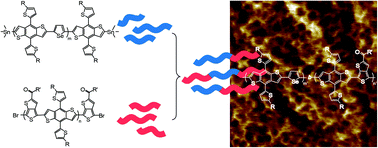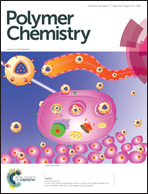‘Blocky’ donor–acceptor polymers containing selenophene, benzodithiophene and thienothiophene for improved molecular ordering†
Abstract
Controlling the phase-separation behavior and achieving an ideal morphology has turned into one of the most important challenges in the field of polymer electronics. In this study we report a straightforward route to ‘blocky’ copolymers that incorporates selenophene into a benzodithiophene (BDT)–thienothiophene (TT) donor–acceptor system for improved molecular ordering. The blocky structure preserves the optical properties of the parent polymers, which is different than an analogue employing purely statistical sequence. Peak force quantitative nanomechanical mode atomic force microscopy reveals a more ordered network-like morphology in blocky polymer:PC71BM films. However the photovoltaic properties of blocky polymers are still lower than the physical mixtures of the two parent polymers. This blocky copolymer approach can be applied to many other polymerization methods to prepare many new types of blocky D–A polymers. As such, it could be a new tool for tuning the polymer crystallinity, and eventually achieving controllable solid-state morphology for polymer electronic applications.


 Please wait while we load your content...
Please wait while we load your content...